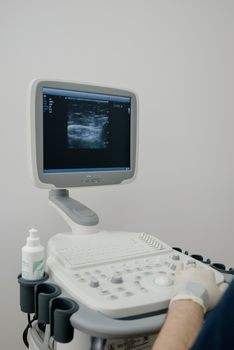Carotid Ultrasound
Carotid ultrasound, a non-invasive imaging technique, has become a pivotal tool in the realm of cardiovascular diagnostics, offering valuable insights into the health of the carotid arteries – the major blood vessels supplying the brain. This high-frequency sound wave-based imaging modality serves as a crucial component in the assessment of vascular health, aiding in the early detection and management of conditions that may impact blood flow to the brain.
The procedure involves the use of a handheld device called a transducer, which emits sound waves and captures the echoes as they bounce back from the carotid arteries. These echoes are then transformed into detailed, real-time images that provide a comprehensive view of the arterial structure, detecting potential abnormalities such as plaque buildup, stenosis, or other vascular issues.
Carotid ultrasound plays a pivotal role in identifying atherosclerosis, a condition characterized by the accumulation of fatty deposits (plaque) on the arterial walls. These plaques may restrict blood flow or, if they rupture, trigger the formation of blood clots, leading to serious complications such as strokes. Early detection of atherosclerosis through carotid ultrasound allows for timely intervention and the implementation of preventive measures to reduce the risk of stroke.

One of the key advantages of carotid ultrasound is its ability to assess blood flow velocity and detect hemodynamic changes within the carotid arteries. Doppler ultrasound, an adjunct to carotid ultrasound, provides information about blood flow patterns, helping healthcare professionals identify areas of stenosis or turbulence that may contribute to cardiovascular issues.
Carotid ultrasound is routinely used in risk stratification for individuals with a history of cardiovascular diseases or those displaying risk factors such as hypertension, diabetes, or smoking. The procedure aids in evaluating the overall vascular health of the patient and guides healthcare providers in formulating personalized treatment plans to mitigate potential risks.
The non-invasive nature of carotid ultrasound makes it a safe and well-tolerated procedure, allowing for repeated assessments over time to monitor changes in vascular health. Additionally, carotid ultrasound serves as a valuable tool in guiding medical interventions, such as carotid endarterectomy or angioplasty, when warranted by the severity of arterial blockages.
In conclusion, carotid ultrasound stands as a beacon in cardiovascular imaging, offering a detailed and accessible means of assessing the health of the carotid arteries. From early detection of atherosclerosis to risk stratification and ongoing monitoring, carotid ultrasound plays a crucial role in preserving vascular health and preventing potential cardiovascular events




